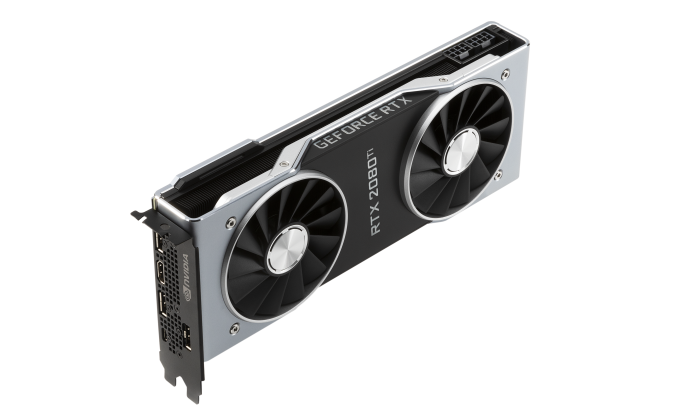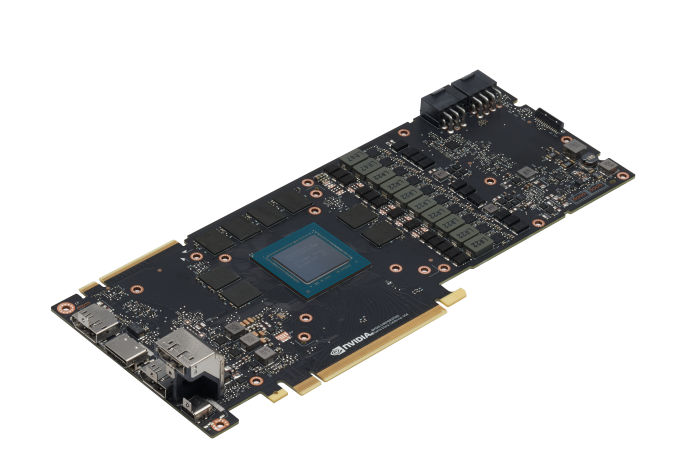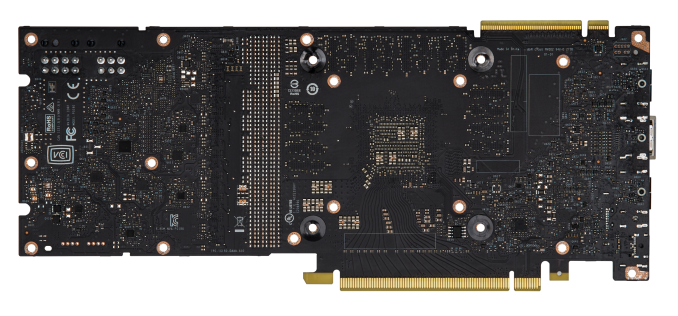The NVIDIA GeForce RTX 2080 Ti & RTX 2080 Founders Edition Review: Foundations For A Ray Traced Future
by Nate Oh on September 19, 2018 5:15 PM EST- Posted in
- GPUs
- Raytrace
- GeForce
- NVIDIA
- DirectX Raytracing
- Turing
- GeForce RTX
Meet The GeForce RTX 2080 Ti & RTX 2080 Founders Editions Cards
Moving onto the design of the cards, we've already mentioned the biggest change: a new open air cooler design. Along with the Founders Edition specification changes, the cards might be considered 'reference' in that they remain a first-party video card sold direct by NVIDIA, but strictly-speaking they are not because they no longer carry reference specifications.
Otherwise, NVIDIA's industrial design language prevails, and the RTX cards bring a sleek flattened aesthetic over the polygonal shroud of the 10 series. The silver shroud now encapsulates an integrated backplate, and in keeping with the presentation, the NVLink SLI connectors have a removable cover.
Internally, the dual 13-blade fans accompany a full-length vapor chamber and component baseplate, connected to a dual-slot aluminum finstack. Looking at improving efficiency and granular power control, the 260W RTX 2080 Ti Founders Edition features a 13-phase iMON DrMOS power subsystem with a dedicated 3-phase system for the 14 Gbps GDDR6, while the 225W RTX 2080 Founders Edition weighing in with 8-phases main and 2-phases memory.
As is typical with higher quality designs, NVIDIA is pushing overclocking, and for one that means a dual 8-pin PCIe power configuration for the 2080 Ti; on paper, this puts the maximum draw at 375W, though specifications-wise the TDP of the 2080 Ti Founders Edition against the 1080 Ti Founders Edition is only 10W higher. The RTX 2080 Founders Edition has the more drastic jump, however, with 8+6 pins and a 45W increase over the 1080's lone 8 pin and 180W TDP. Ultimately, it's a steady increase from the power-sipping GTX 980's 165W.
One of the more understated changes comes with the display outputs, which thanks to Turing's new display controller now features DisplayPort 1.4 and DSC support, the latter of which is part of the DP1.4 spec. The eye-catching addition is the VR-centric USB-C VirtualLink port, which also carries an associated 30W not included in the overall TDP.
Something to note is that this change in reference design, combined with the seemingly inherent low-volume nature of the Turing GPUs, cuts into an often overlooked but highly important aspect of GPU sales: big OEMs in the desktop and mobile space. Boutique system integrators will happily incorporate the pricier higher-end parts but from the OEM’s perspective, the GeForce RTX cards are not just priced into a new range beyond existing ones but also bringing higher TDPs and no longer equipped with blower-style coolers in its ‘reference’ implementation.
Given that OEMs often rely on the video card being fully self-exhausting because of a blower, it would certainly preclude a lot of drop-in replacements or upgrades – at least not without further testing. It would be hard to slot into the standard OEM product cycle at the necessary prices, not to mention the added difficulty in marketing. In that respect, there is definitely more to the GeForce RTX 20 series story, and it’s somewhat hard to see OEMs offering GeForce RTX cards. Or even the RT Cores themselves existing below the RTX 2070, just on basis of the raw performance needed for real time ray tracing effects at reasonable resolutions and playable framerates. So it will be very interesting to see how the rest of NVIDIA’s product stack unfolds.
















337 Comments
View All Comments
Qasar - Friday, September 21, 2018 - link
burntmybacon just like popinfresh, i guess you will never understand the concept of " no competition, we can charge what ever we want, and people will STILL buy it cause it is the only option if you want the best or fastest " it has NOTHING to do with knowing cost info or what a companies profit margins are... but i guess you will never understand this as welleva02langley - Thursday, September 20, 2018 - link
Once again, not AMD fault if Nvidia is trying to corner AMD with new hardware gimmicks like physix, and charging the customers.You never intended in buying an AMD card anyway, you just want a more affordable Nvidia solution. Guess what, pay for it or leave it.
Even by earning 100K a year, I refuse to pay the gimmick tax. I will buy Navi at release. Screw Nvidia.
V900 - Wednesday, September 19, 2018 - link
What a cool piece of technology!Raytracing would be amazing to have in games, and it really is the future of gaming. Its crazy to think there will be games with it already next year. (And some later this year!)
Is it too expensive? Meh, we are talking about TWENTY BILLION transistors squeezed into the area of a postage stamp.
People pay 600-1000$ for a phone, and some have no problem paying 1000$ for a CPU or a designer chair.
7-1200$ isn’t an unreasonable price for a cutting edge GPU that’s capable of raytracing and will be fast enough for the newest games for years to come.
imaheadcase - Wednesday, September 19, 2018 - link
Did that nvidia check cash they sent you to promote the items yet?shabby - Wednesday, September 19, 2018 - link
Definitely a shill, its too obvious.tamalero - Thursday, September 20, 2018 - link
Theres way too many here defending nvidia just because "its a huge chip".That means nothing for the consumer. We're not buying SIZE, we're buying PERFORMANCE AND FEATURES.
mapesdhs - Wednesday, September 26, 2018 - link
Some of the pro-RTX posts sound more like basic trolling though, just to stir things up. If they're getting paid to post +ve stuff, they're doing a pretty rotten job of it. :DformulaLS - Wednesday, September 19, 2018 - link
Your comments sounds like a paid ad. There is no decency excuse for the prices they are charging.DigitalFreak - Wednesday, September 19, 2018 - link
He has a point. People are willing to pay $1000 for a phone, $1000 for a CPU, but $1000 for a high end graphics card is outrageous? I wish the pricing was cheaper, but I'm not having a fit over it. If people don't want to pay the price, they won't. If Nvidia doesn't sell the numbers they want, they'll probably cut the price somewhat.Fritzkier - Wednesday, September 19, 2018 - link
The $1000 phone actually had more technological advancement... And it's an SoC not individual parts...About a $1000 CPU, it's normal because it's enthusiast product (e.g. Threadripper or i9). There's no $1000 i7 or Ryzen 7...
Nvidia shouldn't have made 2080 Ti. They should've made Titan Turing or something...